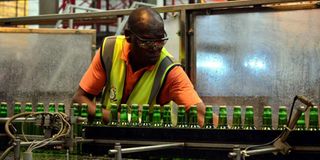Taxes, politics biggest threat to Kenya's economic recovery

A Kenya Breweries Limited line manager examines a bottle of Tusker Malt as it goes through processing at the factory plant located in Ruaraka. It is one of the firms expected to make gains with easing of Covid-19 restrictions.
What you need to know:
- Lockdown measures and a curfew forced restaurants to shut down or operate sub-optimally while shoppers limited expenditure to essentials.
- Another bright investment spot are banking counters, which took a huge hit during the pandemic.
Tax increases and politics are seen as the biggest challenges to recovery as analysts look for bright spots to invest in the Kenyan economy.
Egyptian investment firm EFG Hermes says the rise in political temperatures ahead of a plebiscite on Building Bridges Initiative and 2022 general election are likely to dampen recovery post-Covid-19.
The firm’s analysts say the market is already reflecting more uncertainty about Kenya’s political path than it did two years before the 2017 elections.
“Current valuation multiples are similar to those in the period leading up to the elections in 2017. Precedent suggests the market will trade at these multiples until there is better visibility on the presidential elections in 2022 and on whether any constitutional changes will happen in the meantime,” EFG Hermes said in a research note.
Genghis Capital research, however, says blue chip companies such as East African Breweries show prospects of recovery, although they may face rise in taxes as the government tries to play catch up following the decline in tax revenues last year.
“The latest comments by the Treasury secretary indicate that revenue underperformance remains a drag on the overall fiscal balance, with the government considering a supplementary budget early in 2021 to control the widening deficit. This comes amidst a backdrop of the debt-to-GDP ratio having approached 70 per cent, pointing to tight fiscal space,” EFG Hermes said.
Lockdown measures and a curfew forced restaurants to shut down or operate sub-optimally while shoppers limited expenditure to essentials, which has affected collection by the Kenya Revenue Authority (KRA).
Exchequer collections fell 15.03 percent, or Sh33.27 billion, in the first two months of this fiscal year to Sh188.08 billion on prolonged knock-on effects of the Covid-19 containment measures on economic activity.
The taxman hopes to recover as economic activity picks up even as it implements the electronic track and trace system Excisable Goods Management System (EGMS).
It is estimated that Kenya has an installed capacity in excess of 500,000 bottles an hour which translates to 12 million a day, 360 million a month and 4.32 billion a year.
The EGMS was expanded to cover non-alcoholic beverages (soft drinks, juices and bottled water) in November 2019 and was set to account for more than 70 percent of the volume of products marked by the system.
Bright investment spot
Restrictions on social events hit EABL quite hard as revenues fell 9.0 percent year on year and net profit declined 39 percent to Sh7 billion.
EABL is expected to get a 63 percent recovery on its revenues on senator keg and beer sales following loosening of coronavirus restrictions.
Another bright investment spot are banking counters, which took a huge hit during the pandemic following the slowing down of the economy scrapping of mobile money charges and higher provisions for bad loans.
Analysts expect a rebound in non-interest revenue due to an uptick in transaction volumes, as well as the potential re-introduction of mobile banking fees.
They also expect revenues to be boosted by rising cost of loans which could jump by up to 1.5 percent if the Central bank of Kenya yields to pressure from banks to allow them raise the cost of borrowing in line with market forces.
Although interest rate caps were removed in 2019, banks were required to develop loan pricing formulas to be approved by CBK.
The regulatory gridlock and a lower CBR is partly the reason average lending rates dropped to 11.92 percent in October – record lows that were last witnessed in the early 1980s.
Over the last few months Kenya has seen some of the lowest average lending rate since the CBK started disclosing the rate in July 1991 during the reign of the then Moi-era governor Eric Kotut and matches annual borrowing costs disclosed by the World Bank in 1980.
Bankers say they are still in talks with the regulator over how the models will look like including factors that go into the pricing model, such as cost of funds, risk premium because of non-performing loan or return on assets and an element of operating costs.
As a result of the delays in approving the new models and increased risk of bad loans banks have continued to lend to the government while denying the private sector loans.
Credit to the private sector grew by 8.2 percent year on year to November 2020 with Sh151.7 billion loan mediation between April to November 2020 period.





